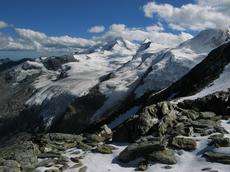How mountain ranges get their shape

(PhysOrg.com) -- Tectonic, climate and the topography of the mountain ranges interact through a complex system of interactions and feedbacks. The nature and strength of these links are examined on the basis of data collection of 69 mountain ranges over the five continents.
Continental and oceanic crusts are "floating" on earth’s mantle. When two continental plates collide to each other, they shorten and thicken. Since continental crust has a lower density than mantle, it raises above the surrounding and form a mountain range. Climate (rain, glaciers, wind, temperature variability etc.), coupled with the rate of crustal thickening are crucial to determine the erosion rate of the mountain range, as well as its overall shape.
Interaction of tectonic and ice
The nature of these interactions and feedbacks is examined by an international team lead by Jean-Daniel Champagnac (Ambizione Fellow) at the geological Institute of the ETH Zürich. This team recently published a study that constrain the strength of these interactions on the basis of measured tectonic, climatic and topographic values of different (69) mountain ranges widely distributed on the Earth surface. This study ran over six year in parallel to the main projects of the researchers involved. The goal was to examine the plausible laws of mountain building by data collection and statistical analyses.
For all the mountain ranges considered, the scientists determined specific quantitative variables. The climate was considered using the latitude (as a proxy for mean temperature and sun insolation), together with mean annual precipitation. The tectonic variable was defined by the shortening rate across each range, determined by GPS. As measures of the topography, the scientists used the averaged and maximum elevation above a base level previously defined, as well as relief calculated over different scale.
Latitude takes considerable impact
The statistical analyses confirm that the shape of mountain ranges result on the interaction between tectonics and climate. “That is trivial, but this is the first time that this is documented a global scale from natural data”, says Champagnac. Surprisingly, the importance of tectonic processes seems to be less important than so far assumed. Tectonic shortening is essential to thicken the crust, but climate exerts a stronger influence to shape the topography, according to this study. The relief is not sensitive to the average amount of precipitation, but to a combination of crustal shortening and latitude, where glaciations are more likely: small scale relief directly result on glacial imprint, whereas large scale relief result on crustal shortening.
The Alps are in a special situation, fully glaciated during glacial cycles, and almost fully deglaciated during the interglacial times: this produces very efficient glacial erosion and permanent reshaping of the landscape, by switching between glacial and fluvial erosion, says Champagnac.
Now the question arises whether tectonic processes were up to now overestimated.
More information: Champagnac, J. - D., et al: Tectonics, Climate, and Mountain Topography, J. Geophys. Res. (2012), doi:10.1029/2011JB008348 , in press.
Provided by ETH Zurich


















